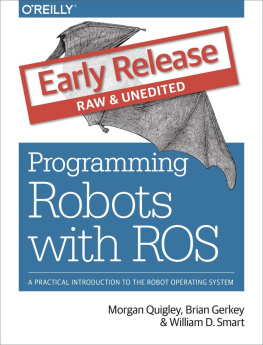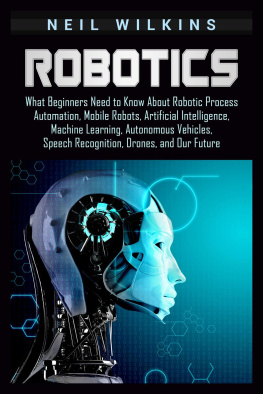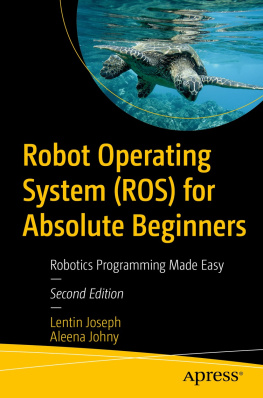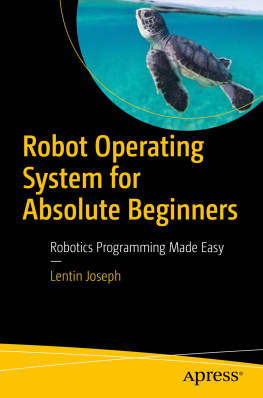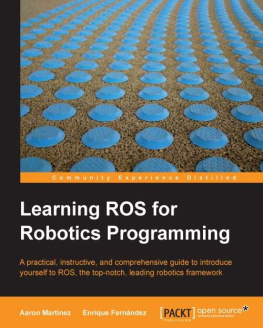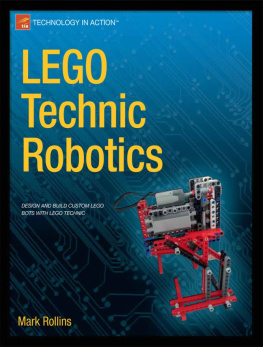Programming Robots with ROS
by Morgan Quigley , Brian Gerkey , and William D. Smart
Copyright 2016 Morgan Quigley, Brian Gerkey, and William D. Smart. All rights reserved.
Printed in the United States of America.
Published by OReilly Media, Inc. , 1005 Gravenstein Highway North, Sebastopol, CA 95472.
OReilly books may be purchased for educational, business, or sales promotional use. Online editions are also available for most titles (http://safaribooksonline.com). For more information, contact our corporate/institutional sales department: 800-998-9938 or corporate@oreilly.com .
- Acquisitions Editor: Mike Loukides
- Editors: Meghan Blanchette and Dawn Schanafelt
- Production Editor: Matthew Hacker
- Copyeditor: Rachel Head
- Proofreader: Amanda Kersey
- Indexer: WordCo Indexing Services, Inc.
- Interior Designer: David Futato
- Cover Designer: Ellie Volckhausen
- Illustrator: Rebecca Demarest
- December 2015: First Edition
Revision History for the First Edition
See http://oreilly.com/catalog/errata.csp?isbn=9781449323899 for release details.
The OReilly logo is a registered trademark of OReilly Media, Inc. Programming Robots with ROS, the cover image of a Salim Alis fruit bat, and related trade dress are trademarks of OReilly Media, Inc.
While the publisher and the authors have used good faith efforts to ensure that the information and instructions contained in this work are accurate, the publisher and the authors disclaim all responsibility for errors or omissions, including without limitation responsibility for damages resulting from the use of or reliance on this work. Use of the information and instructions contained in this work is at your own risk. If any code samples or other technology this work contains or describes is subject to open source licenses or the intellectual property rights of others, it is your responsibility to ensure that your use thereof complies with such licenses and/or rights.
978-1-4493-2389-9
[LSI]
Preface
ROS, the Robot Operating System, is an open source framework forgetting robots to do things. ROS is meant to serve as acommon software platform for people who arebuilding and using robots. This common platform letspeople share code and ideas more readily and, perhaps moreimportantly, means that you do not have to spend years writingsoftware infrastructure before your robots start moving!
ROS has been remarkably successful. At the time of writing, in theofficial distribution of ROS, there are over 2,000 software packages,written and maintained by almost 600 people. Approximately 80commercially available robots are supported, and we can find at least1,850 academic papers that mention ROS. We no longer have to writeeverything from scratch, especially if were working with one of themany robots that support ROS, and can spend more time thinking aboutrobotics, rather than bit-fiddling and device drivers.
ROS consists of a number of parts:
- A set of drivers that let you read data from sensors and sendcommands to motors and other actuators, in an abstracted,well-defined format. A wide variety of popular hardware issupported, including a growing number of commercially availablerobot systems.
- A large and growing collection of fundamental robotics algorithmsthat allow you to build maps of the world, navigate around it,represent and interpret sensor data, plan motions, manipulateobjects, and do a lot of other stuff. ROS has become very popular inthe robotics research community, and a lot of cutting-edgealgorithms are now available in ROS.
- All of the computational infrastructure that allows you to movedata around, to connect the various components of a complex robotsystem, and to incorporate your own algorithms. ROS is inherentlydistributed and allows you to split the workload across multiplecomputers seamlessly.
- A large set of tools that make it easy to visualize the state of therobot and the algorithms, debug faulty behaviors, and record sensordata. Debugging robot software is notoriously difficult, and thisrich set of tools is one of the things that make ROS as powerful asit is.
- Finally, the larger ROS ecosystem includes an extensive set ofresources, such as a wiki that documents many of the aspects of theframework, a question-and-answer site where you can ask for help andshare what youve learned, and a thriving community of users anddevelopers.
So, why should you learn ROS? The short answer is because it willsave you time. ROS provides all the parts of a robot software systemthat you would otherwise have to write. It allows you to focus on theparts of the system that you care about, without worrying about the partsthat you dont care about.
Why should you read this book? Theres a lot of material on the ROSwiki, including detailed tutorials for many aspects of the framework.A thriving user community is ready to answer your questions onhttp://answers.ros.org. Why not just learn ROS from these resources?What weve tried to do in this book is to lay things out in a moreordered way and to give comprehensive examples of how you can use ROSto do interesting things with real and simulated robots. Weve alsotried to include tips and hints about how to structure your code, howto debug your code when it causes the robot to do somethingunexpected, and how to become part of the ROS community .
Theres a fair amount of complexity in ROS, especially if youre not aseasoned programmer; distributed computation, multithreading,event-driven programming, and a host of other concepts lie at the heartof the system. If youre not already familiar with at least some ofthese, ROS can have a daunting learning curve. This book is anattempt to flatten out that curve a bit by introducing you to thebasics of ROS and giving you some practical examples of how to use itfor real applications on real (and simulated) robots.
Who Should Read This Book?
If you want to make your robots do things in the real world, but dontwant to spend time reinventing the wheel, then this book is for you.ROS includes all of the computational infrastructure youll need toget your robots up and running and enough robotics algorithms to getthem doing interesting things quickly.
If youre interested in some particular aspect, like path planning, and want toinvestigate it in the context of a larger robot system, then this bookis for you. Well show you how to get your robot doing interestingthings using the infrastructure and algorithms in ROS and how to swapout some of the existing algorithms for your own.
If you want to get an introduction to the basic mechanisms of ROS andan overview of some of the things that are possible, but youre a bitdaunted by the scale of the information on the wiki, then this book isfor you. Well give you a tour of the basic mechanisms and tools inROS and concrete examples of complete systems that you can build onand adapt.
Who Should Not Read This Book?
Although we dont want to exclude anyone from reading this book, itsprobably not the right resource for everyone. We make certainimplicit assumptions about the robots that you will be using. Theyare probably running Linux, and have decent computational resources(at least equivalent to a laptop computer). They have sophisticatedsensors, such as a Microsoft Kinect. They are ground-based, andprobably can move about the world. If your robots dont fall into atleast some of these categories, the examples in this book might not beimmediately relevant to you, although the material on the underlyingmechanisms and tools should be.


